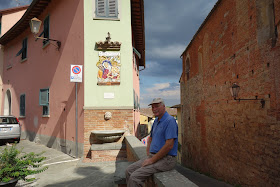Travel: Tuscany, Italy
One day, almost a year ago, I received an email from Great Value Vacations offering a package deal to Italy. The package included free airfare from Los Angeles to Rome and back, a Hertz car, and ten nights in hotels in Tuscany and in Rome. The deal was superb, and we booked it. We went there in mid-September.
Our first stop was the Chianti region in Tuscany, in the Castello Di Montegufoni, which dates back to the 10th or 11th century. The castle has been beautifully restored with, not just rooms, but apartments. The grounds are just as lovely. The view from our apartment was fantastic; we could see Tuscany's rolling hills with vineyards, cypress trees, and another huge castle or villa on a ridge.
I kept thinking the Castle Montegufoni is the perfect place for a writer to hole up and work, but we were too busy sightseeing and I had little time to write. Even my blogging suffered because the WiFi service was spotty and I could only use my Smartphone to post in Facebook.
It was a pleasant, low-key visit, but a welcome one. When we later visited Florence, Sienna, and Rome, the tourists were as thick as locusts.
I'll stop right here. Enjoy the pictures and stay tuned for more blog entries about our visit to Italy.
Be sure and read my other blog entries about Italy:
Florence American Cemetery, Volterra, and La Verna.
Florence Tuscany in September
To those interested, I'm quoting Wikipedia's landmarks of San Miniato:
The city is enclosed within a well-preserved medieval precinct. Main landmarks include:
- The Tower of Frederick, built by Frederick II in the 13th century on the summit of the hill at an elevation of 192 metres (630 ft), overlooking the entire Valdarno. Here was imprisoned Frederick's chanchellor Pier delle Vigne until his death. During World War II it was destroyed by the German Army to prevent the Allies from using it as a gun sighting tower, but was reconstructed in 1958.
- The Duomo (Cathedral), dedicated to both Sant'Assunta and Santo Genesio or Saint Genesius of Rome. It was originally a Romanesque building, but it has been remodelled several times and exhibits Gothic and some Renaissance arcchitectural elements. The façade incorporates a number of colorful majolica bowls. The interior has Latin cross plan with a central nave with two side aisles. The cathedral's campanile, a fortification annexed in is called the Matilde Tower and features an asymmetrical clock.
- The Diocesan Museum, next to the cathedral. This museum-gallery contains works by Filippo Lippi, Jacopo Chimenti, Neri di Bicci, Fra Bartolomeo, Frederico Cardi (known as Cigoli) and Verrocchio.
- Palazzo dei Vicari, built by Emperor Otto IV during the 12th century, the palazzo incorporates one of the oldest known crenellated turrets. The interior has a number of interesting frescoes. It is now an hotel.
- Palazzo Comunale. This 14th-century building is still San Miniato's Town Hall. Its great hall was decorated by Cenno di Francesco Cenni. It also features a small oratory, containing a 16th-century altarpiece.
- The church of San Francesco. Originally built in the early 13th century with a Romanesque façade, its interior features Gothic style chapels and frescoes from the 14th and 15th centuries.
- The church of San Domenico was originally constructed in the 14th century, but has an incomplete façade. Its interior contains terracotta works by Luca della Robbia, a fresco attributed to Masolino da Panicale and a burial monument sculpted by Donatello. Next to the façade begins the Via Angelica, a tunnel that connected the countryside to the city.
- Convent of San Francesco. Purportedly founded by Saint Francis of Assisi himself in 1211 when he visited the city, the Convent stands behind the city higher up on the hill.
Other buildings and monuments worth seeing include the Bishop's Sanctuary, with a Baroque façade in the design of an amphitheater, designed by Cigoli and the Sanctuary of the Crucifix, recently restored, the desanctified Chiesa di San Martino, which has done duty as a convent, and then a prison, but which will now be used for conventions.
There are also a number of Renaissance palazzi, built by such aristocratic families as the Roffia, Grifoni, Formichini and the Bonapartes, ancestors of Napoleon.
Read also
- Travel Italy: Rome the Eternal City
- Travel Tuscany: The Blue Sky of Siena, Italy
- Travel Italy: Florence American Cemetery, Volerra, La Verna
- Travel Italy: Florence Tuscany in September
- The Link to the Amazon - Manaus, Brazil
- Salvador, Brazil - the Center of Bahian Culture
- Foz do Iguazu, Mighty Falls fo Brazil and Argentina
- Mariana and Ouro Preto - Colonial Towns in Minas Gerais, Brazil
- Falling in Love With Rio de Janeiro

Tags: Italy, Tuscany, travel, San Miniato, truffles, food, Castle Montegufoni, Chianti
This is all for now,





























No comments:
Post a Comment